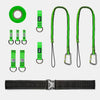5 Tips to Prevent Falling Tools
Safety at Height starts at the Source
Working at heights involves risks, falling tools are one of the most common hazards. Falling tools can not only cause damage to the environment, but also serious injuries or even fatal accidents. This makes it crucial to take preventive measures.
In this article we share 5 practical tips based on the occupational hygiene strategy to prevent falling tools. We explain how source control , collective measures , and personal protective equipment contribute to a safe workplace.
1. Source approach: Carry out preparatory work on the ground
Preventing risks starts at the source. Ask yourself: what can I prepare on the ground before working at height? Tasks such as assembling parts or organizing tools can often be safely completed before entering the workspace at height.
In addition, only take the tools you actually need. Fewer tools means less chance of falling. This requires good work preparation, but it reduces the risk considerably.
2. Source Control: Prevent Falling Tools with Tool Tethering
One of the most effective ways to secure tools is by using tool tethering . Using certified lanyards and anchor points, you can secure tools to your body, tool belt, or a fixed structure. This prevents the tool from falling, even if it slips out of your hand.
The benefits of tool tethering:
- Protection for everyone under your workplace : Prevent accidents with passers-by, colleagues or equipment.
- High user-friendliness : Modern lanyards such as the NLG Tool Lanyards meet the strictest standards (ANSI/ISEA 121-2018) and are designed for efficient use.
- Increased productivity : No need to waste time retrieving or replacing dropped tools.
Expert Tip: According to medical research, it is recommended to carry a maximum of 1.5 kg on the wrist, up to 10 kg on the belt or body, and always attach heavier equipment to a fixed anchor point.
3. Collective measures: Safety nets such as the NLG Spacenet or Drop Net

Even with source measures, something can always go wrong. That is why it is important to use collective solutions, such as safety nets . Products such as the NLG Spacenet or the NLG Drop Net can not only catch tools, but also small materials or debris.
The benefits:
- Protects large groups of people at once.
- Holds both heavy tools and small parts, such as screws or bolts.
- Easy to install under work platforms.
Safety nets are a smart addition to personal measures, especially in environments where several people work at height at the same time.
4. Keep your workspace organized with bags and holsters

A cluttered workspace at height is a recipe for accidents. Make sure tools are always neatly stored away when not in use. Use Tool Bags , Tool Holsters or Tool Pouches to keep everything organised.
Products like the NLG Lifting Bags not only provide ample storage space, but are also designed to prevent tools from falling out, even when in motion. By investing in quality storage solutions, you minimize the chance of incidents.
5. Use certified tool lanyards and strong anchor points

Not all tool lanyards are created equal. It is essential to use only certified products that are strong enough to handle the weight of your tools. For example, NLG Tool Lanyards have been independently tested and meet the strictest ANSI/ISEA 121-2018 standards. This gives you the assurance that they can withstand heavy loads.
You should also pay attention to the strength of your anchor points. Make sure they are suitable for the weight of your tools and meet the applicable safety standards.
Conclusion: Safe working starts with the right measures
Preventing falling tools requires a combination of measures that go beyond personal protective equipment. By combining source control, collective measures and the right tools such as certified lanyards and safety nets, you can drastically reduce the risk of accidents.
Want to learn more about how tool tethering can contribute to a safer workplace? Take a look at our range and discover how NLG Tool Lanyards and other products can take your safety to the next level.
Receive helpful safety tips and information about new products:




